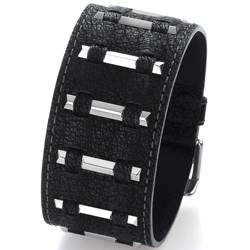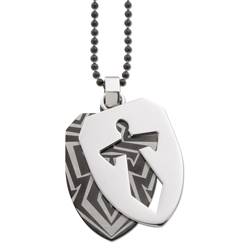Blokes and the bling thing
 2.1 k views | By Stuart Braun
2.1 k views | By Stuart Braun
The current season of men’s jewellery is peppered with pieces that are both unique and stylish. STUART BRAUN reports.
In February this year, UK-based Retail Jeweller Magazine journalist Lucy Reiter listed her “Ten Trends that Rocked the Noughties”, an article focusing predominately upon the rise of gold prices, the prevalence of branding and the success of self-purchasing women; however, sliding into tenth spot was “Bling: jewellery for men”.
“With male rappers flashing impossibly-large diamond rings, earrings and pendants,” Reiter wrote of the past decade, “it was cool for men to adorn themselves with jewels. The upshot of this was a gap in the market for the jewellery sector to exploit, resulting in an explosion of jewellery brands just for men.”
While Australia has only recently picked up on this thriving jewellery niche, local retailers and suppliers have made a history of looking to Europe for any hints that might help them to bring accessory-averse Australian males into the jewellery fold. Their efforts appear to be working, according to figures from industry analyst Ibisworld that show the Australian men’s jewellery market as growing by four per cent a year over the last five years. By comparison, overall jewellery sales have increased by under one per cent.
Though coming off a low base, men’s jewellery in Australia is outstripping the rest of the market, and now comprising 10 per cent of all local retail sales ($350 million per annum). That’s not bad for a market that barely existed just a decade ago.
Watches, cufflinks and wedding bands remain men’s jewellery mainstays, but contemporary men are also embracing branded adornments to complement a well-crafted fashion identity.
To capture this emerging market, retailers are branching from more generic men’s lines into brands with a fashion-forward edge. Chez Shaz Jewellers in Sydney’s Double Bay is now stocking men’s lines from fashion jewellery labels Thomas Sabo and Tuskc, according to director Mary Harding. “They are both keeping with today’s styles and trends. The Thomas Sabo range tends to be more out there and I am hoping Australian men will take to it,” she says of a range that includes Rebel at Heart sterling silver pendants featuring outré gothic crosses and 60’s-inspired peace symbols.
Harding fears that the cliché of the conservative Australian male still holds true. “I think Australians in general, not just men, are not very adventurous in their jewellery selection,” she adds. “We all need to look out of the box but men are slower and more hesitant in following jewellery trends.”
In 2010, this should be changing, according to Ian MacGowan, senior industry analyst at Ibisworld: “Along with the rise of the metrosexual and changing male perceptions about wearing jewellery, men’s media like GQ, Men’s Style and FHM have really pushed men’s jewellery in collaboration with designer brands.”
Like the wider market, which in recent years has seen prestige statement-pieces spurned in favour of lower-cost fashion jewellery purchased in much higher volumes, men’s jewellery has grown around “bling with less sting”, a trend driven by the middle-market strategies of prestige brands, MacGowan adds: “Armani, Diesel and Hugo Boss were very prestigious but are now pitched as premium brands producing fashion men’s jewellery including watches, pendants and cufflinks with cheaper materials.”

Bruno Banani from Osjag
Men have always worn stainless steel, but they are now trying on non-traditional materials like leathers, woods, polished stones and chrome metal finishes central to stylish but affordable ranges. Suppliers have accordingly looked beyond gold or silver cufflinks to coloured stainless steel, as seen in the Hardware Collection from Cudworth Enterprises.
“The use of IP plating (ion plating) is becoming popular as we are starting to see new colours in stainless steel jewellery,” notes Cudworth director Darren Roberts. The Hardware range is both masculine and adventurous, including necklets and bracelets in an array of fashion colours including black, brown, purple and navy.” Craig Symons of Sydney supplier Osjag jewellery believes a wider selection of men’s jewellery is partly responsible for its rise in popularity, stating, “Gone are the days of just the gold or silver ring and chain. Recently it is becoming more acceptable and even fashionable for men to wear bracelets, necklaces and earrings.”
Roberts agrees. “While cufflinks and watches still receive strong demand, the Australian man is prepared to wear rings, bracelets and pendants in either crosses or dog tags,” he says, adding that another key to the success of the Hardware range is its flexibility: “It comes unassembled so unique jewellery pieces can be created and added to at will.”
Following on from the charm explosion in women’s jewellery, it seems men are buying into the idea of unique, personalised pieces that can be mixed and matched depending on the wearer’s mood or, dare it be said, emotion.
One of the great successes in changeable men’s jewellery has been the Yukon line distributed by supplier RJ Scanlan & Co as part of the Teno range. Featuring high-quality German design, this modish rubber and steel bracelet with changeable elements ranges in price from around $150 to over $3000. The bracelet can be customised with a variety of pieces made from steel, gold, wood, horn, mother of pearl and diamond, and can be ordered complete or piece by piece.
“Yukon sales are up 300 percent in the last year,” RJ Scanlan general manager Stephen Brown says. “The main thing about Yukon is that it’s selling through, and because of this, people are talking to each other about it.”
According to Brown, Yukon sales remains driven by female consumers who purchase it for their partners, fathers and sons, something that is indicative of the industry as a whole. For this reason, Symons adds, much of the marketing of all new men’s jewellery products continues to target females.
“Advertising and marketing need to be focussed on men’s media, but women need to be targeted too. We all know how powerful a woman’s opinion is on her man,” he says.
“Yukon stockists have said it works well as an add-on sale to women who are already buying,” Brown says. “Retailers can say, ‘What about something for your man?’”.

Tuskc
Men who are shopping alone seem to be more at ease entering branded fashion stores, one-stop-shops that include apparel, accessories, eyewear, and even cosmetics, according to MacGowan, and it is in these stores that men’s jewellery is experiencing most of its growth. “A lot of the growth in the men’s market is driven by men going out to purchase for themselves,” argued MacGowan. “These men are more fashion conscious, and feel better able to access retail fashion stores on their own without someone else there.”
The sentiment is backed by a December 2009 Ibisworld report entitled “Cosmetics-consuming boy meets cashed up, car-shopping girl”, which noted that “the rise of the metrosexual, and in more recent years the uber-sexual male, has seen the spending behaviour of men shift – with men spending more on cosmetics, personal grooming and fashion than ever before.”
Labels like Teno, though currently sold exclusively at jewellery retailers, will ultimately need to be pushed via a growing network of brand-heavy accessory and fashion stores whose publicity power, especially in new media, should flow into more traditional stockists.
Brown suggests that it might be time to open Teno-only branded stores to push the range. “We are seriously considering the option, with the idea of using that as a focus for our advertising,” he says. “The trend is to do this; all the watch companies are doing this, thus helping to drive sales into other areas.”
Though the current focus on POS marketing and promotion has so far sufficed, Brown is aware that branded men’s jewellery has huge potential through the kind of above-the-line push used in big magazines by Tag Heuer, Diesel, Armani and the like. This will be the strategy for RJ Scanlan’s emerging Soho line, aimed at 20-30 year old men with high disposable incomes and a strong fashion identity – those “who are not afraid to spend $200 on a silver ring,” Brown says, specifying that he ultimately wants to focus on quality and longevity, and “not something as abruptly fashion as Diesel”.
In the long term, men’s jewellery lines will need to marry hip styling with quality and timelessness, especially in wedding bands and watches that continue to drive much of the market. Osjag, for instance, has just released the Steel & Gold Collection, a range of men’s wedding bands from Saint Maurice of Germany that combine the masculinity of stainless steel with the luxury of 18-carat yellow or rose gold.
By marrying contemporary style with precision quality and strategic branding, local retailers and suppliers should enjoy continuing strong growth in the relatively unchartered Australia men’s jewellery market.
Posted May 01, 2010